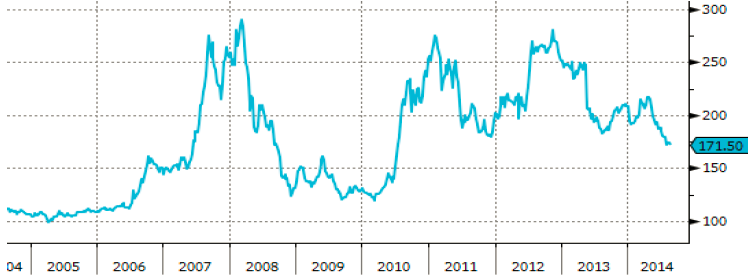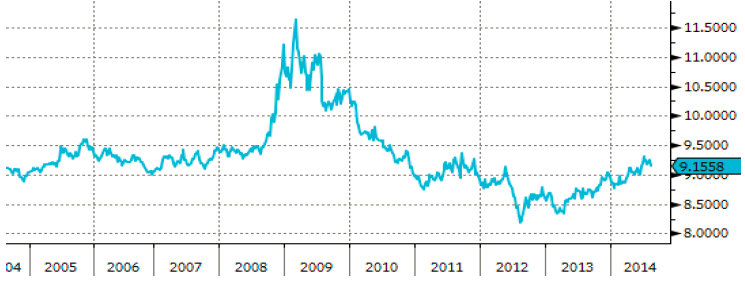Analys
Handelsbanken Jordbruk, 22 augusti 2014

Skörd 2015
Spannmålspriserna har gått ned en hel del under det gångna året – en följd av globala rekordskördar på alla de tre stora grödorna vete, majs och sojabönor. Även 2013 var volymmässigt ett bra skördeår och 2014 blir andra året på raken med relativt stor lageruppbyggnad. Vete MATIF november 14 handlas i skrivande stund på EUR 171 (SEK 1.565) per ton – så sent som i april i år var samma kontrakt uppe på EUR 210 (SEK 1.985) per ton. Under 2013 handlades november 14-kontraktet stundtals ännu högre.
Vad vi upplever just nu är att lantbrukare som för nästa års skörd istället köper på termin (spekulerar i en prisuppgång och ökar sin risk) till antalet är klart fler än de lantbrukare som säljer på termin (skyddar sig mot ytterligare prisfall). Om det var djurproducenter som prissäkrade kommande foderinköp vore det mer förståeligt – men så är inte fallet, få av dessa har vaknat på samma sätt. Om denna riskvilja lönar sig vet ingen, främst bör det bero på huruvida väderproblem uteblir i världens större spannmålsregioner även under 2015 eller ej – om inte finns det skäl att tro att priserna kan pressas ytterligare nedåt.
Grafen nedan visar närmsta rullande termin på MATIF för de senaste tio åren – med tre väldigt tydliga pristoppar, intressant nog alla på nästan samma nivå.
- 2006-07 ökade spannmålspriserna kraftigt som följd av minskad global produktion i kombination med ökad efterfrågan inte minst som energigröda.
- Efter att vete MATIF handlats ned mot EUR 120 per ton fick vi sommaren 2010 återigen en kraftig prisuppgång – värme och torka gjorde att ryska vetefält praktiskt taget brann upp, varpå Ryssland senare införde exportförbud av spannmål i syfte att dämpa inhemsk inflation.
- 2012 blev allt annat än problemfritt – Ryssland fick ännu lägre veteskörd än 2010, den amerikanska majsen upplevde den värsta torkan på över 50 år och jämfört med året innan föll produktionen i varierande grad i Europa, Australien och Sydamerika.
Kort sagt – vi har de senaste åren haft kraftiga prisuppgångar och även ett högt genomsnittspris men inte utan anledning.
Decemberterminen vete MATIF 2015 handlas just nu kring EUR 186 (SEK 1.705) per ton – en nivå som alltså verkar locka mer till köp än sälj även för producenter. Med ögonen på ovanstående vetegraf, med klart lägre nivåer bara för några få år sedan, kan det ses som förvånande att riskviljan är så stor. Märk väl att Handelsbankens vy inte är att priserna ska falla ytterligare, vi håller för tillfället en neutral vy i väntan på mer prognoser om höstsådden och potential för nästa års skörd men också i en tid av hög politisk oro där utfallet är svårt att sia om. Däremot är vi väldigt säkra på att risken för ytterligare prisfall åtminstone existerar.
Vad man heller inte bör bortse från är att EUR/SEK under perioden med låga spannmålspriser kring 2009 stundtals handlades bra mycket högre än idag, se graf nedan. En svag svensk krona i förhållande till euron gynnar svenska spannmålspriser och givetvis tvärtom. Handelsbankens prognos för EUR/SEK under det fjärde kvartalet 2015 är 8,75 – ganska väl i linje med de europeiska storbankernas snittprognos. Faller dessa prognoser in bör det alltså pressa ned svenska inhemska spannmålspriser.
Det är bråda dagar för landets spannmålsbönder, årets skörd är långt ifrån klar på många håll i landet – tyvärr med stora nederbördsrelaterade problem i inte minst i Halland och Västergötland. Och efter skörd ska det sås. Ändock kan det finnas skäl att, om inte annat när regnet faller och tröskan står stilla, fundera på hur riskerna kring nästa års skörd ska hanteras. Är verkligen dessa EUR 186 (SEK 1.705) per ton för lågt för att sälja ens en liten del? Kanske är säljoptioner intressant i detta läge – med vilka ett skydd mot fallande priser ges samtidigt som möjlighet att ta del av eventuell uppsida finns kvar. På nästföljande sidor följer några exempel med säljoptioner vete MATIF september 2015 för den som är intresserad.
Säljoptioner ger ibland ett bättre utfall än terminer och ibland tvärtom. Då produktionsnivån inte är helt säker bör heller inte hela volymen prissäkras. En kombination av dessa tre val är kanske det rätta. En tredjedel i varje är ett möjligt alternativ – med då två tredjedelar skyddat mot prisfall och två tredjedelar med möjlighet till att ta del av prisuppgång.
Säljoptioner
En säljoption ger innehavaren en rättighet men inte en skyldighet att få sälja underliggande termin* till en viss förbestämd prisnivå (lösenpris) – vilket innebär att om terminspriset handlas över lösenpriset utnyttjar innehavaren inte sin säljoption och kan istället dra nytta av ett högre försäljningspris för fysisk vara. Ett köp av en option kommer aldrig kosta köparen mer än kostnaden för optionen, den s.k. premien.
*Vid affär med Handelsbanken hanterar banken försäljning och köp på börsen och betalar mellanskillnaden direkt till kund.
Följande visar exempel på möjligheter inför skörd 2015:
Lösenpriset kan köparen välja själv och kan således vara både högre och lägre än i ovanstående exempel. Som synes kommer premien variera efter valt lösenpris – en säljoption med ett högre lösenpris kostar mer än en säljoption med ett lägre lösenpris. Oavsett lösenpris finns inga fasta nivåer på premien utan dessa beräknas vid varje affärstillfälle då nivån på dessa även är beroende av främst löptid och volatiliteten på underliggande terminskontrakt. Löptiden är nu relativt lång, men allt annat lika blir alltså dessa optioner billigare med tiden.
Antag att en lantbrukare köper den säljoption som i exemplet ovan har lösenpriset SEK 1.700 per ton och betalar premien SEK 137 per ton. Utfallet av denna affär om optionen behålls till förfallodatum blir då som följer utifrån några olika scenarion – vetepriset faller 20 procent, förblir oförändrat eller stiger 20 procent:
Vi antar i dessa exempel ett fysiskt vetepris som är exakt i nivå med terminspriset på MATIF.
Det kan tilläggas att köparen av en säljoption kan välja att sälja tillbaka optionen när som helst innan löptidens slut, alltså i detta fall innan den 17:e augusti.
Huruvida säljoptioner är ett mer attraktivt instrument att skydda sig mot ett prisfall än terminer finns det inget stående svar på, det varierar inte minst utifrån rådande prisnivå – dels på vetet och dels på prmien. I ovanstående utfall vore terminer en bättre lösning då priset föll och då priset var oförändrat – givetvis som följd av kostnaden för premien. Men när priset stiger kan en säljoption alltså bli ett klart mer fördelaktigt val, utan av ge avkall på skydd mot nedsida.
Om lantbrukaren tycker att premien i ovanstående exempel är dyr kan en option med ett lägre lösenpris väljas. Nedanstående tabell visar utfallet med samma tre scenarion som ovan om säljoptionen med lösenpriset SEK 1.650 per ton valts:
Som vi ser blev resultatet här något bättre i de fall då priset förblev oförändrat eller steg – som följd av att premien i detta fall var lägre med SEK 114 mot SEK 137. Dock var inte skyddet mot ett prisfall lika starkt, p.g.a. ett lägre lösenpris, och utfallet då priset föll blev alltså sämre.
Fördelen med att istället välja ett högre lösenpris är att skyddet mot nedsidan blir starkare – dock till en högre kostnad. Nedanstående tabell visar utfallet för den dyraste av säljoptionerna av de tre alternativen i tabell 1, den med lösenpriset SEK 1.750 per ton.
Som synes gav ett högre lösenpris med tillhörande högre premie ett bättre resultat när priset föll på bekostnad av en mer begränsad uppsida.
[box]Handelsbanken Jordbruk är producerat av Handelsbanken och publiceras i samarbete och med tillstånd på Råvarumarknaden.se[/box]
Ansvarsbegränsning
Detta material är producerat av Svenska Handelsbanken AB (publ) i fortsättningen kallad Handelsbanken. De som arbetar med innehållet är inte analytiker och materialet är inte oberoende investeringsanalys. Innehållet är uteslutande avsett för kunder i Sverige. Syftet är att ge en allmän information till Handelsbankens kunder och utgör inte ett personligt investeringsråd eller en personlig rekommendation. Informationen ska inte ensamt utgöra underlag för investeringsbeslut. Kunder bör inhämta råd från sina rådgivare och basera sina investeringsbeslut utifrån egen erfarenhet.
Informationen i materialet kan ändras och också avvika från de åsikter som uttrycks i oberoende investeringsanalyser från Handelsbanken. Informationen grundar sig på allmänt tillgänglig information och är hämtad från källor som bedöms som tillförlitliga, men riktigheten kan inte garanteras och informationen kan vara ofullständig eller nedkortad. Ingen del av förslaget får reproduceras eller distribueras till någon annan person utan att Handelsbanken dessförinnan lämnat sitt skriftliga medgivande. Handelsbanken ansvarar inte för att materialet används på ett sätt som strider mot förbudet mot vidarebefordran eller offentliggörs i strid med bankens regler.
Analys
Tightening fundamentals – bullish inventories from DOE

The latest weekly report from the US DOE showed a substantial drawdown across key petroleum categories, adding more upside potential to the fundamental picture.

Commercial crude inventories (excl. SPR) fell by 5.8 million barrels, bringing total inventories down to 415.1 million barrels. Now sitting 11% below the five-year seasonal norm and placed in the lowest 2015-2022 range (see picture below).
Product inventories also tightened further last week. Gasoline inventories declined by 2.1 million barrels, with reductions seen in both finished gasoline and blending components. Current gasoline levels are about 3% below the five-year average for this time of year.
Among products, the most notable move came in diesel, where inventories dropped by almost 4.1 million barrels, deepening the deficit to around 20% below seasonal norms – continuing to underscore the persistent supply tightness in diesel markets.
The only area of inventory growth was in propane/propylene, which posted a significant 5.1-million-barrel build and now stands 9% above the five-year average.
Total commercial petroleum inventories (crude plus refined products) declined by 4.2 million barrels on the week, reinforcing the overall tightening of US crude and products.


Analys
Bombs to ”ceasefire” in hours – Brent below $70

A classic case of “buy the rumor, sell the news” played out in oil markets, as Brent crude has dropped sharply – down nearly USD 10 per barrel since yesterday evening – following Iran’s retaliatory strike on a U.S. air base in Qatar. The immediate reaction was: “That was it?” The strike followed a carefully calibrated, non-escalatory playbook, avoiding direct threats to energy infrastructure or disruption of shipping through the Strait of Hormuz – thus calming worst-case fears.

After Monday morning’s sharp spike to USD 81.4 per barrel, triggered by the U.S. bombing of Iranian nuclear facilities, oil prices drifted sideways in anticipation of a potential Iranian response. That response came with advance warning and caused limited physical damage. Early this morning, both the U.S. President and Iranian state media announced a ceasefire, effectively placing a lid on the immediate conflict risk – at least for now.
As a result, Brent crude has now fallen by a total of USD 12 from Monday’s peak, currently trading around USD 69 per barrel.
Looking beyond geopolitics, the market will now shift its focus to the upcoming OPEC+ meeting in early July. Saudi Arabia’s decision to increase output earlier this year – despite falling prices – has drawn renewed attention considering recent developments. Some suggest this was a response to U.S. pressure to offset potential Iranian supply losses.
However, consensus is that the move was driven more by internal OPEC+ dynamics. After years of curbing production to support prices, Riyadh had grown frustrated with quota-busting by several members (notably Kazakhstan). With Saudi Arabia cutting up to 2 million barrels per day – roughly 2% of global supply – returns were diminishing, and the risk of losing market share was rising. The production increase is widely seen as an effort to reassert leadership and restore discipline within the group.
That said, the FT recently stated that, the Saudis remain wary of past missteps. In 2018, Riyadh ramped up output at Trump’s request ahead of Iran sanctions, only to see prices collapse when the U.S. granted broad waivers – triggering oversupply. Officials have reportedly made it clear they don’t intend to repeat that mistake.
The recent visit by President Trump to Saudi Arabia, which included agreements on AI, defense, and nuclear cooperation, suggests a broader strategic alignment. This has fueled speculation about a quiet “pump-for-politics” deal behind recent production moves.
Looking ahead, oil prices have now retraced the entire rally sparked by the June 13 Israel–Iran escalation. This retreat provides more political and policy space for both the U.S. and Saudi Arabia. Specifically, it makes it easier for Riyadh to scale back its three recent production hikes of 411,000 barrels each, potentially returning to more moderate increases of 137,000 barrels for August and September.
In short: with no major loss of Iranian supply to the market, OPEC+ – led by Saudi Arabia – no longer needs to compensate for a disruption that hasn’t materialized, especially not to please the U.S. at the cost of its own market strategy. As the Saudis themselves have signaled, they are unlikely to repeat previous mistakes.
Conclusion: With Brent now in the high USD 60s, buying oil looks fundamentally justified. The geopolitical premium has deflated, but tensions between Israel and Iran remain unresolved – and the risk of missteps and renewed escalation still lingers. In fact, even this morning, reports have emerged of renewed missile fire despite the declared “truce.” The path forward may be calmer – but it is far from stable.
Analys
A muted price reaction. Market looks relaxed, but it is still on edge waiting for what Iran will do

Brent crossed the 80-line this morning but quickly fell back assigning limited probability for Iran choosing to close the Strait of Hormuz. Brent traded in a range of USD 70.56 – 79.04/b last week as the market fluctuated between ”Iran wants a deal” and ”US is about to attack Iran”. At the end of the week though, Donald Trump managed to convince markets (and probably also Iran) that he would make a decision within two weeks. I.e. no imminent attack. Previously when when he has talked about ”making a decision within two weeks” he has often ended up doing nothing in the end. The oil market relaxed as a result and the week ended at USD 77.01/b which is just USD 6/b above the year to date average of USD 71/b.

Brent jumped to USD 81.4/b this morning, the highest since mid-January, but then quickly fell back to a current price of USD 78.2/b which is only up 1.5% versus the close on Friday. As such the market is pricing a fairly low probability that Iran will actually close the Strait of Hormuz. Probably because it will hurt Iranian oil exports as well as the global oil market.
It was however all smoke and mirrors. Deception. The US attacked Iran on Saturday. The attack involved 125 warplanes, submarines and surface warships and 14 bunker buster bombs were dropped on Iranian nuclear sites including Fordow, Natanz and Isfahan. In response the Iranian Parliament voted in support of closing the Strait of Hormuz where some 17 mb of crude and products is transported to the global market every day plus significant volumes of LNG. This is however merely an advise to the Supreme leader Ayatollah Ali Khamenei and the Supreme National Security Council which sits with the final and actual decision.
No supply of oil is lost yet. It is about the risk of Iran closing the Strait of Hormuz or not. So far not a single drop of oil supply has been lost to the global market. The price at the moment is all about the assessed risk of loss of supply. Will Iran choose to choke of the Strait of Hormuz or not? That is the big question. It would be painful for US consumers, for Donald Trump’s voter base, for the global economy but also for Iran and its population which relies on oil exports and income from selling oil out of that Strait as well. As such it is not a no-brainer choice for Iran to close the Strait for oil exports. And looking at the il price this morning it is clear that the oil market doesn’t assign a very high probability of it happening. It is however probably well within the capability of Iran to close the Strait off with rockets, mines, air-drones and possibly sea-drones. Just look at how Ukraine has been able to control and damage the Russian Black Sea fleet.
What to do about the highly enriched uranium which has gone missing? While the US and Israel can celebrate their destruction of Iranian nuclear facilities they are also scratching their heads over what to do with the lost Iranian nuclear material. Iran had 408 kg of highly enriched uranium (IAEA). Almost weapons grade. Enough for some 10 nuclear warheads. It seems to have been transported out of Fordow before the attack this weekend.
The market is still on edge. USD 80-something/b seems sensible while we wait. The oil market reaction to this weekend’s events is very muted so far. The market is still on edge awaiting what Iran will do. Because Iran will do something. But what and when? An oil price of 80-something seems like a sensible level until something do happen.
-

 Nyheter4 veckor sedan
Nyheter4 veckor sedanMahvie Minerals växlar spår – satsar fullt ut på guld
-

 Analys4 veckor sedan
Analys4 veckor sedanA muted price reaction. Market looks relaxed, but it is still on edge waiting for what Iran will do
-

 Nyheter3 veckor sedan
Nyheter3 veckor sedanJonas Lindvall är tillbaka med ett nytt oljebolag, Perthro, som ska börsnoteras
-

 Nyheter3 veckor sedan
Nyheter3 veckor sedanOljan, guldet och marknadens oroande tystnad
-

 Nyheter3 veckor sedan
Nyheter3 veckor sedanDomstolen ger klartecken till Lappland Guldprospektering
-

 Analys3 veckor sedan
Analys3 veckor sedanTightening fundamentals – bullish inventories from DOE
-

 Nyheter2 veckor sedan
Nyheter2 veckor sedanRyska staten siktar på att konfiskera en av landets största guldproducenter
-

 Nyheter2 veckor sedan
Nyheter2 veckor sedanSommarvädret styr elpriset i Sverige















